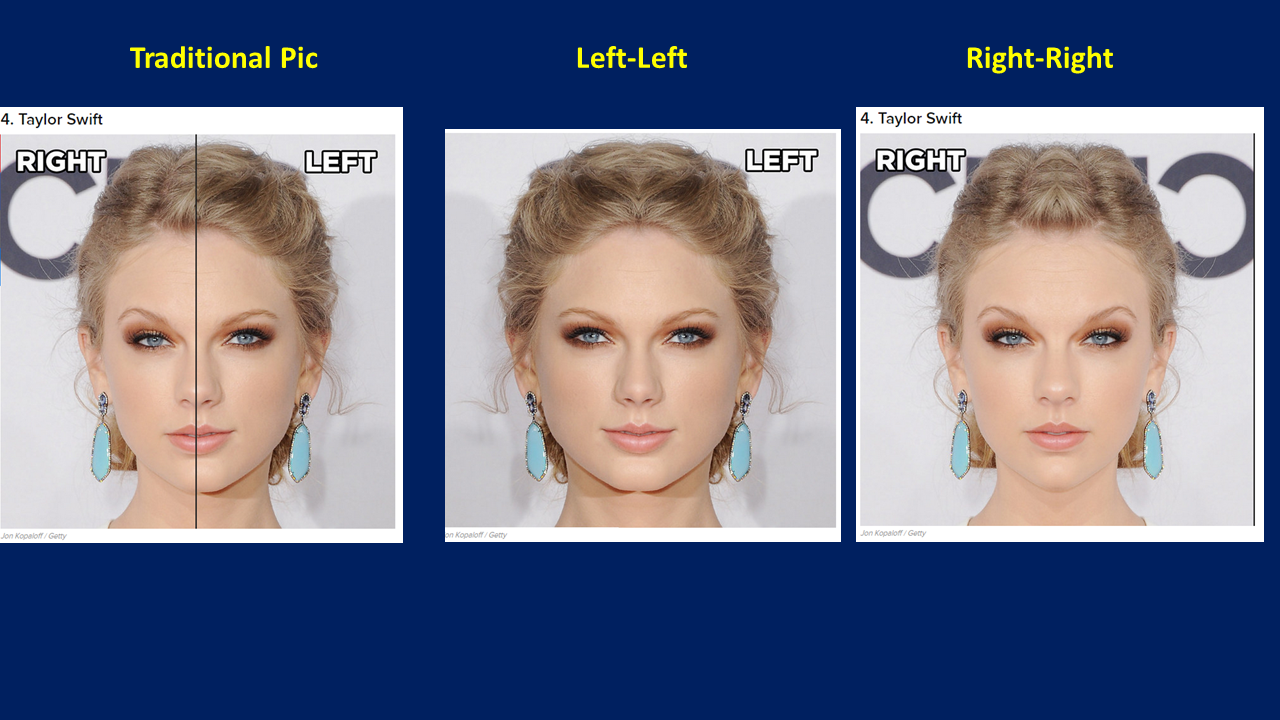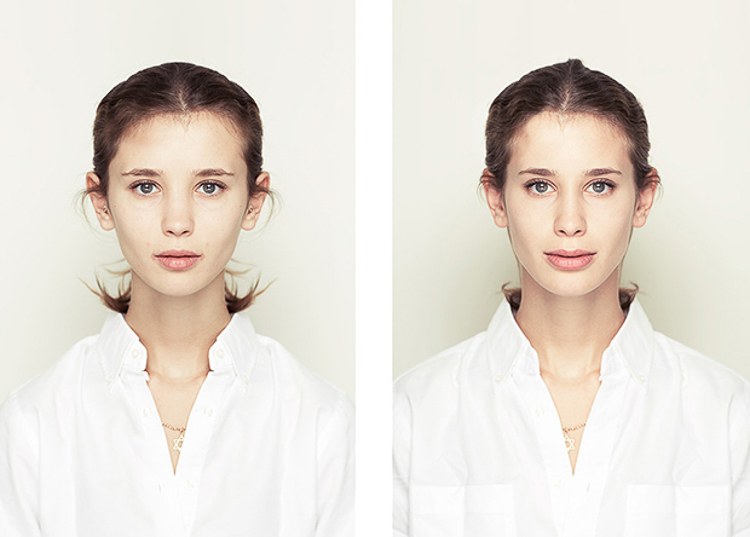Facial Symmetry Test: Find Out Your Face's Balance!
Is your face a perfect reflection, a flawless mirror image of itself? The truth is, facial symmetry, or the lack thereof, is a fascinating aspect of human appearance, and understanding it can offer valuable insights into both our aesthetics and our overall well-being.
In the realm of facial aesthetics, the concept of symmetry often takes center stage. A symmetrical face, as the term suggests, presents an almost identical appearance on both sides when bisected by a vertical line down the middle. The features eyes, nose, mouth, and chin align in a harmonious, balanced arrangement. Conversely, an asymmetrical face deviates from this perfect mirroring, exhibiting subtle or noticeable differences between its two halves. These discrepancies can manifest in various ways, from variations in eye size and shape to differences in cheekbone prominence or the position of the nose. These seemingly minor variations can have a significant impact on our perceptions of beauty and attractiveness.
To delve deeper into this intriguing topic, let's consider a hypothetical case: a renowned artist, known for their meticulous attention to detail and appreciation for balance. We will use this fictional individual as our point of reference.
- Mothers Warmth Chapter 3 Jackermans Heartwarming Journey
- Beware Legit Streameast Domains Streaming Issues
| Full Name: | Evelyn Sterling |
| Date of Birth: | March 15, 1978 |
| Place of Birth: | London, England |
| Nationality: | British |
| Education: | Royal Academy of Arts, London |
| Field: | Visual Arts (Painting, Sculpture) |
| Career Highlights: |
|
| Notable Style: | Emphasis on form, light, and shadow; often explores themes of identity and perception. |
| Influences: | Old Masters, modern sculptors, and the natural world. |
| Website: | Example Art Gallery |
The pursuit of facial symmetry is not merely a superficial endeavor; it touches upon fundamental aspects of human perception and the science of attractiveness. Consider this: when presented with faces, our brains are wired to rapidly assess them, often within milliseconds. Symmetry, in this context, acts as a powerful signal. It suggests health, genetic fitness, and developmental stability. Faces that exhibit higher degrees of symmetry are often deemed more attractive across cultures, a phenomenon that has been observed and studied extensively by researchers.
One of the primary methods for assessing facial symmetry involves the use of technology. Advanced AI-powered systems are now available that can analyze facial features with remarkable precision. By uploading a photograph, these systems identify and map key facial landmarks such as the eyes, nose, mouth, and chin. These landmarks serve as reference points for measuring distances, angles, and proportions. Based on this analysis, a symmetry score is generated, offering a quantifiable measure of the balance between the left and right sides of the face. These tools provide a personalized symmetry score that provides a detailed breakdown of the individuals unique facial characteristics, with emphasis on proportion and balance.
Its important to understand that while symmetry is often associated with beauty, perfect symmetry is exceedingly rare in the natural world. In fact, a face that is 100% symmetrical might even appear unnatural or, in some cases, less appealing. The human eye is accustomed to subtle variations, the minor imperfections that give faces character and individuality. Its the interplay between symmetry and asymmetry that makes each face unique. This is where the concept of asymmetry comes into play.
- Jeff Ross Health Update What You Need To Know Latest News
- Park Sunghoon Ryu Hyunkyungs Relationship Details Updates
Asymmetry is defined as any deviation from perfect mirroring between the two sides of the face. These discrepancies can be almost imperceptible or quite noticeable, and can influence the overall aesthetic impression. Some individuals have more pronounced asymmetries than others. Asymmetry is present in almost everyone's faces, making the study of facial symmetry all the more interesting. Asymmetry is when there are discrepancies.
The causes of facial asymmetry are varied. Some asymmetries are present from birth, possibly due to genetic factors or developmental irregularities. Others develop over time, influenced by lifestyle habits, aging, or injuries. For example, factors such as weight loss, dental treatments, and muscle tone can affect facial balance. Additionally, external influences, such as sun exposure and environmental damage can impact facial symmetry. Furthermore, new, noticeable asymmetry may be a sign of a serious condition like Bells palsy or stroke, so it is essential to consult with a healthcare professional if you experience any sudden changes in facial symmetry.
For those curious about their own facial symmetry, several avenues of exploration exist. One approach involves the use of simple visual techniques. Take a photograph of your face, ideally a straight-on shot with a neutral expression. Then, you can examine the photo to assess symmetry. Another method involves printing the photo and, using a ruler and level, carefully comparing the placement of your features on both sides. However, these methods can be subjective, as they depend on visual assessment. Therefore, it is highly recommended to use technologies, such as online symmetry analysis tools to ensure greater accuracy. It's as easy as uploading a photo, and a comprehensive symmetry analysis is available within seconds.
There are numerous apps and websites available that provide facial symmetry analysis. Prettyscale is easy to use. You can upload a photo and receive your face rating and analysis report in minutes. These AI-powered tools will evaluate your photos and provide feedback, offering valuable insights into the balance and proportions of your facial features.
For a more in-depth analysis, consider exploring tools that provide a face attractiveness score. These systems analyze the geometric proportions of facial features such as the eyes, nose, lips, etc., and the distance between those. The detailed feedback can help you understand what features of your face are contributing to your beauty score. Whether you're driven by curiosity or seeking a boost in confidence, these assessments can be a fun and informative exercise. Your face symmetry can change over time due to aging, lifestyle habits, or injuries.
For those who are interested in improving facial symmetry, there are some strategies that may prove helpful. One simple method involves adjusting your posture. Maintaining an upright posture, with your shoulders back and your head level, can have a positive effect on facial symmetry. Facial exercises, such as the various forms of face yoga, are claimed by some to have benefits, although there is no definitive clinical research to support such claims. A healthy lifestyle, encompassing regular skincare and healthy habits is also very important.
Keep in mind that the pursuit of perfect symmetry is not the ultimate goal. Sometimes, achieving a slightly more balanced and symmetrical appearance is possible, but the subtle imperfections that make each face unique are often more captivating. We are not striving for a perfectly symmetrical face because sometimes too much of a good thing doesnt always provide the best results. For a laugh, experiment with different angles, tilted heads, and placing the midline in different places. Play around and have fun.
The analysis tools provide detailed feedback to better understand your facial features. When the face analysis is finished, you are able to see which features of your face determine your beauty score. Regular skincare and healthy habits help maintain a more symmetrical face.
As an additional note, the symmetry of a child's face will typically improve over time as they grow older, and their facial features develop and mature. One key takeaway is that faces that are more symmetrical are considered beautiful.
Facial asymmetry is a natural characteristic, and a subtle amount of asymmetry is common. If you're wondering if your face is symmetrical, the best way to test it is by printing out of a photo of your face. In reality, most people dont have that kind of balance. With the right techniques, you can improve the symmetry of your face and achieve a more balanced and aesthetic look.
In essence, the quest for facial symmetry is a journey of self-discovery. By understanding the nuances of asymmetry, exploring available tools, and embracing the unique characteristics that make each face distinctive, individuals can gain a deeper appreciation for their own features and celebrate the beauty of individuality.



Detail Author:
- Name : Prof. Paxton Hauck
- Username : dora05
- Email : koch.tressie@hotmail.com
- Birthdate : 2004-08-07
- Address : 168 Brown Inlet Suite 583 North Baby, KY 35695-9373
- Phone : +1-317-659-0151
- Company : Gislason-Hartmann
- Job : Packer and Packager
- Bio : Non aut id vitae explicabo. Dolor facere quas similique magnam. Et voluptas aut suscipit at voluptatem et.
Socials
tiktok:
- url : https://tiktok.com/@reba3637
- username : reba3637
- bio : Sed omnis quibusdam quisquam ut.
- followers : 3054
- following : 178
linkedin:
- url : https://linkedin.com/in/rebaschuster
- username : rebaschuster
- bio : Et doloribus nihil voluptatum eius nam.
- followers : 2529
- following : 1631
facebook:
- url : https://facebook.com/rebaschuster
- username : rebaschuster
- bio : Et occaecati repellendus quos voluptates beatae molestiae saepe.
- followers : 561
- following : 190
instagram:
- url : https://instagram.com/reba_schuster
- username : reba_schuster
- bio : At enim natus ut reiciendis molestiae. Aperiam quis autem excepturi.
- followers : 4896
- following : 2545
twitter:
- url : https://twitter.com/reba.schuster
- username : reba.schuster
- bio : Voluptas quos blanditiis voluptas cupiditate. Et enim nesciunt et ipsa. Magnam dolorem aliquam consequatur cum quia necessitatibus.
- followers : 168
- following : 2582